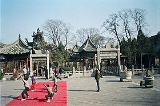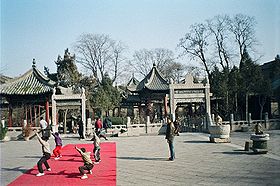
Muslim Chinese martial arts
Encyclopedia

Hui people
The Hui people are an ethnic group in China, defined as Chinese speaking people descended from foreign Muslims. They are typically distinguished by their practice of Islam, however some also practice other religions, and many are direct descendants of Silk Road travelers.In modern People's...
started and adapted many of the styles of Chinese martial arts
Chinese martial arts
Chinese martial arts, also referred to by the Mandarin Chinese term wushu and popularly as kung fu , are a number of fighting styles that have developed over the centuries in China. These fighting styles are often classified according to common traits, identified as "families" , "sects" or...
such as Bajiquan
Bajíquán
Bājíquán is a Chinese martial art that features explosive, short-range power and is famous for its elbow strikes. It originated in Hebei Province in Northern China, but is also well-known in other places today, especially Taiwan...
, Piguaquan
Piguaquan
Piguaquan , also known as Piguazhang due to its emphasis on palm techniques, is often practiced along with Bajiquan and is a style of wushu that features explosive, long-range power...
, Liu He Quan, and other styles.
There were specific areas known to be centers of martial arts, such as Cang County
Cangzhou
Cangzhou is a prefecture-level city in Hebei province, People's Republic of China. Cangzhou's urban center has a population of approximately 514,074 at the 2010 census which correspond to the built up area), while the prefecture-level administrative region in total has a population of 7,134,053...
in Hebei Province
Hebei
' is a province of the People's Republic of China in the North China region. Its one-character abbreviation is "" , named after Ji Province, a Han Dynasty province that included what is now southern Hebei...
.
- Huihui Shiba Zhou ( - "HuiHui peopleThe Hui people are an ethnic group in China, defined as Chinese speaking people descended from foreign Muslims. They are typically distinguished by their practice of Islam, however some also practice other religions, and many are direct descendants of Silk Road travelers.In modern People's...
elbow eighteen style") is reputedly a traditional style of martial arts practiced by the Hui. It was considered lost, but in 1970 it was announce that one Ju Kui, born 1886, was a living master of the style. - Although bajiquanBajíquánBājíquán is a Chinese martial art that features explosive, short-range power and is famous for its elbow strikes. It originated in Hebei Province in Northern China, but is also well-known in other places today, especially Taiwan...
is not practiced exclusively by Hui, there are still many famous Hui practitioners of the style today, including Wu Lianzhi (the lineage holder of the style from Meng Village), Ma Xianda, Ma Lingda, Ma Mingda, and others. - Zhaquan (ChāquánChaquánChāquán is a Chinese martial art that features graceful movements and some acrobatic aerial maneuvers.Chāquán also includes a large range of weapons....
) is widely practiced throughout China, but particularly in ShandongShandong' is a Province located on the eastern coast of the People's Republic of China. Shandong has played a major role in Chinese history from the beginning of Chinese civilization along the lower reaches of the Yellow River and served as a pivotal cultural and religious site for Taoism, Chinese...
and HenanHenanHenan , is a province of the People's Republic of China, located in the central part of the country. Its one-character abbreviation is "豫" , named after Yuzhou , a Han Dynasty state that included parts of Henan...
, Zhaquan features graceful, extended movements, as well as various acrobatic maneuvers and many weapons. Famous Hui exponents of this style include Zheng HeZheng HeZheng He , also known as Ma Sanbao and Hajji Mahmud Shamsuddin was a Hui-Chinese mariner, explorer, diplomat and fleet admiral, who commanded voyages to Southeast Asia, South Asia, the Middle East, and East Africa, collectively referred to as the Voyages of Zheng He or Voyages of Cheng Ho from...
, an admiral of the Ming DynastyMing DynastyThe Ming Dynasty, also Empire of the Great Ming, was the ruling dynasty of China from 1368 to 1644, following the collapse of the Mongol-led Yuan Dynasty. The Ming, "one of the greatest eras of orderly government and social stability in human history", was the last dynasty in China ruled by ethnic...
, Wang Ziping, Ma Jinbiao, and Zhang Wenguang (who was instrumental in created the modern wushu version of ChangquanChangquanChángquán refers to a family of external martial arts styles from northern China.The forms of the Long Fist style emphasize fully extended kicks and striking techniques, and by appearance would be considered a long-range fighting system...
). - Qishiquan ( - "the seven warriors") was reputedly started among Chinese Muslims in HenanHenanHenan , is a province of the People's Republic of China, located in the central part of the country. Its one-character abbreviation is "豫" , named after Yuzhou , a Han Dynasty state that included parts of Henan...
, and eventually reached ShanxiShanxi' is a province in Northern China. Its one-character abbreviation is "晋" , after the state of Jin that existed here during the Spring and Autumn Period....
. The style, as the name implies, is based on seven essential postures from which sets are constructed. - XinyiXinyi-Mainland China:*Xinyi, Jiangsu , county-level city of Xuzhou, Jiangsu*Xinyi, Guangdong , county-level city of Maoming, Guangdong*Xinyi Glass , a private company engaged in glass manufacturing...
liuhequan ( - "Mind, Intention and Six Harmonies Fist") is a martial art that developed in Henan provinceHenanHenan , is a province of the People's Republic of China, located in the central part of the country. Its one-character abbreviation is "豫" , named after Yuzhou , a Han Dynasty state that included parts of Henan...
. Although practiced and preserved by the Chinese Muslim community in Henan, the style is recognized to be originated by Ji Longfeng (also known as Ji Jike ) of Shanxi province. The Shanxi transmission of this art is carried by the Dai family and transmitted to Li Luoneng, who modified the style more or less into the modern Xingyi practiced widely in Shanxi and Hebei. Since the Dai style Xinyi contains practice originated from the Dai family, the transmission within the Muslim community is considered the most conserved lineage. - PiguaquanPiguaquanPiguaquan , also known as Piguazhang due to its emphasis on palm techniques, is often practiced along with Bajiquan and is a style of wushu that features explosive, long-range power...
("chopping and hanging fist") is generally believed to have been founded by Wu Zhong, a Chinese Muslim from Meng Village, Cang County, Hebei Province.
Wu initially learned the two styles from two Daoist monks Lai and Pi in 1727. Piguaquan is now widely practiced all over China, and features long-arm swinging and chopping techniques, some of which have been adapted and included in modern wushu forms (for example, wulongpanda ). Famous Hui practitioners of Piguaquan today include Ma Xianda, Ma Lingda, and Ma Mingda.
Notable Hui swordsmen
- The Muslim Chinese General Ma HongkuiMa HongkuiMa Hongkui , was a prominent warlord in China during the Republic of China era, ruling the northwestern province of Ningxia. His rank was Lieutenant-general. His courtesy name was Shao-yun .- Life :...
personally wielded DadaoDadaoThe dadao one of the varieties of dao or Chinese saber, is also known as the Chinese great sword. Based on agricultural knives, dadao have broad blades generally between two and three feet long, long hilts meant for "hand and a half" or two-handed use, and generally a weight-forward balance...
swords in combat during training with his troops. General Ma wielding a sword His soldiers also did sword dances with dadao during training. - The Muslim Chinese General Ma Zhongying made his Muslim troops of the 36th Division (National Revolutionary Army)36th Division (National Revolutionary Army)The 36th Division was a cavalry division in the National Revolutionary Army. It was created in 1932 by the Kuomintang for General Ma Zhongying, who was also its first commander. It was made almost entirely out of Hui Muslim troops, all of its officers were Hui, with a few thousand Uighurs forced...
engage in shadow fencing during practice. During the Battle of TutungBattle of TutungThe Battle of Tutung occurred when Ma Zhongying's Chinese Muslim 36th Division was attacked by the Soviet Russian Red Army on the banks of the frozen Tutung river. The battle took place over multiple days, where the Soviet bombers used mustard gas...
, they used these swords to storm Russian machine gun posts.

